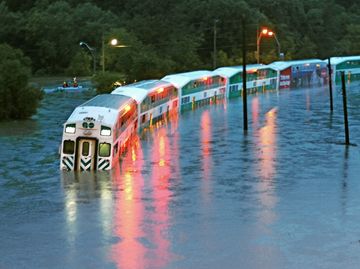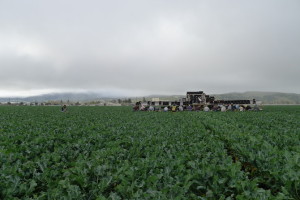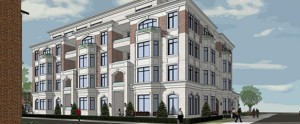 By Staff
By Staff
May 11th, 2016
BURLINGTON, ON
Our colleagues at CATCH (Citizens at City Hall) published a piece on a meeting where the provincial Minister of the Environment and Climate Change spoke of the impact climate change is having on us – Now. Burlington understands what he is talking about – he drives the point even further than the August 2014 flood did,
Ontario’s minister of the environment and climate change had some blunt advice when he spoke at the climate resilient cities conference in Hamilton recently. Glenn Murray offered detailed evidence that climate change already threatens our food and water security and it’s going to get much worse.
While he declared that “there’s nothing that Hamilton lacks to be the kick-ass city in Canada”, the former mayor of Winnipeg made clear that “fundamental transformation” in our urban form is required including intensification and no more suburban sprawl.
“I want to take you to the context of where I think we as a group of leaders have to understand and what the dynamics are,” he began. “And I will just offer the proposition that the two biggest crises that we face on the adaptation and resilience side are food security and water security.”

Glen Murray – Minister of the Environment and Climate Change
He pointed to a Toronto storm three years ago that dumped a month’s rain in one hour and tore out 80 metres of GO train track “that cost us $600 million which could basically pay for half of [Hamilton’s] LRT.” And he cited “false springs” that wiped out the local apple crop in 2012. He also explained the link of many extreme weather events to the melting arctic ice cap and its effect on the polar vortex.
“The jet stream has slowed down by about 20 percent which means that the periods which are wet last longer, the periods which are dry last longer and that causes us to have so many droughts as we saw in the prairies, fires, invasions of species – the beetles that are destroying our forests,” Minister Murray explained. “And then we have moisture levels on the prairies that we haven’t seen since the last ice age – and if we didn’t have the modern irrigation we have now we probably would be courting if not in the dust bowl, and for the first time Calgary and Regina had air quality warnings because of the level of smoke from fires on the prairies.”

The cost of repairing GO train tracks when Toronto experienced flooding would have paid for half of the LRT coming to Hamilton.
He spoke a week before a tinder dry forest and 32C temperatures helped fuel the catastrophic fire in Fort McMurray despite its near sub-arctic location at the same latitude as the northern tip of Ontario and lower Hudson’s Bay.
Murray reminded his audience that last year’s “disruptive spring” experiences included four to five metres of snow “on the streets of Halifax and St John’s” in the last week of April and asked what that would have done in Hamilton. “No one had much of a garden in Atlantic Canada last year. That was also the summer that we had fires on the Prairies the soft fruit crop blossomed in January in BC and died.”
Focusing particularly on food security, the Minister argued that the jet stream destabilization has “had some very bad impacts on our ability to produce food” and warned that “if you want to destabilize a government, all you have to do as a society is just have a food or water shortage for any period of time.”
As an example, he pointed to the extreme drought in the Middle East in 2006-2011 where there was “an 80 percent food crop loss in northern Syria and the fertile crescent about 1.6 million people lost their farms and became the underclass in Damascas, which was according to the Pentagon a swift threat multiplier in the destabilization of the region and the on-going war and then the insertion of terrorism.” Murray noted that “ISIS is hanging onto the three largest irrigation dams … so they’re obviously sophisticated in assessing the power of control of water.”

Fields of California broccoli – 95% of ours comes from here.
Bringing this closer to home, the Minister detailed the development of the California drought where “80 percent of water use is for agriculture” and the National Oceanic and Atmospheric Administration (NOAA) has found the description of extreme drought no longer adequate and has introduced “exceptional drought” into its terminology.
“You see the blood red stain in the middle of California ,” he said pointing to one of his slides. “That’s a piece of real estate that’s very important to your life and to my life because we import $4 billion worth of food as a northern community.”
California, he explained, provides “95 percent of all US broccoli, 92 percent of strawberries, 91% of grapes, 90 percent of tomatoes, 84 percent of all lettuce” and similar percentages to Ontario. While noting that almost all of this is grown in that blood red stained area, Murray warned he “could keep going with all the other things your mother told you to eat lots of when you were growing up.”
A particular “perversity” in the California situation is that nut and pistachio growers are “have now bought surplus drilling equipment from Alberta” and are “going down 2000 feet into the aquifers of California leading to collapse, whereas the vegetable farmers can only afford equipment that goes down about 200 feet.”

Burlington resident weren’t comfortable with a five storey project in the downtown core – developer cut it back to four. This is an absurdity,” Murray declared.
Murray also explained that the climate change we’re already seeing is certain to get significantly worse because carbon dioxide stays in the atmosphere for 40 to 250 years.
“So looking back right now we are experiencing the full force of carbon dioxide levels from 1916, in the middle of the First World War, and we’re just now experiencing the initial impacts of carbon dioxide from 1976 when I graduated from high school.”
He underlined that “sobering” thought by noting that “the rapid explosion of the suburbs in the fifties – the great low density carbon intensive neighbourhoods – all the weight of all of that activity and change in urban form has not yet impacted.”

Burlington Hydro loaned electric BMW’s to city council members top record their driving habits – when will the wave of buying electric cars hit us?
Murray connected this to the province’s commitment to rapid transit by inviting the audience to look at the Yonge subway line in Toronto from the vantage point of the top of the CN tower. “You can clearly see where it is because at every subway stop there are spikes of large commercial and residential buildings all the way up to York,” he said.
He compared that to the Bloor line where city councillors and their residents fight intensification. “There’s a fight over a four-storey building in Etobicoke – they’re fighting it because it’s ‘too intense’. This is the absurdity,” Murray declared.
He didn’t suggest this might happen along Hamilton’s LRT line, but the link was obvious, and he underlined it by the results of a mapping study of taxes versus density that confirmed “all the neighbourhoods who use a lot of infrastructure for a very small tax base are well dispersed suburbs, big box formula subdivisions, and Hamilton.”
He ended with advice to individual Hamiltonians: “Drive less, get an electric vehicle, congratulations on getting a rapid transit line in Hamilton and please use it. Or walk, it’s a beautiful city to walk in.”



















The Province continually forces Halton (everywhere else too) to grow and accommodate more people.
Burlington gets the smaller number of increase, but has, by policy to protect the north and rural area (I support this), been running out of land to continue to grow outwards in sprawl suburbs and density.
Therefore, achieving the people numbers balance means that, to accommodate the growth, the growth must be upwards in floors and density. The trouble is no one seems to know where all this can go and will end up.
More people and cars per acre. No local jobs focus yet to make it live-work, and just garage-style retail that justifies the dense growth condos being termed “mixed use”. There is a lot of turnover and vacancy in these, and not much diversity.
It now seems that we have a dentist shop on every corner.
This is a completely different form of community and demographic from the past, although some can be rationalized.
Aldershot is ripe for just such growth form. The money math of it amplifies the pressure. City politics favours it, and Ward 1 Councilor Craven is leading the way.
Is 6 floors by right not enough he says, how about trying for 8 by right? Pretty soon it will be 10, as some developers openly speculate, and then 12 has been asked for, so the sky is the limit. There is no real process to get this discussion started publically, before the seeds are already in the ground.
The presently protected residential along Plains Rd is supposed to have a “fair” OP and zoning review underway. But developers are jumping the gun and proposing a 4 floors OP and zoning amendment officially, and there is a 6 floor proposal not yet submitted. They don’t want to wait to give residents the fair hearing promised.
But developers have already talked to Planning and to Craven, and so they are not being discouraged by what they hear. They have already had their “fair hearing”, and seem to have gotten a message to act on.
This kind of land speculation leads to inflationary expectations, and if you know anything about the Aldershot property value – redevelopment values scene in this respect then it looks kind of scary I think. In fact, it is nuts.
Now I am not saying that I am opposed to development, and to change, but I still don’t see any overall plan and vision despite having waited for one for years.
I just get tired of seeing a process that doesn’t work for people, only for money and power, with no consideration of consequences for the cost of living.
What I see is piecemeal, hop-scotch proposals driven by huge speculative expectations of gain, building over the top expensive condos of small dimensions, no land, and monster prices.
On the walking or biking options, you can’t do your shopping on foot or bike. Yes, small errands for little nothings, but the real big money shopping doesn’t fit.
I agree with what Brian said. The province will do what they want for growth and developers, and tell us what we have to do to meet their dictates.
It doesn’t matter what people want or think, or what it does to them. That is becoming very apparent, and is what I hate about it. It’s a rigged process.
In other words, his government will do all in it’s power to make sure that no matter how people want to live, their way is the right way, and that you’re an idiot if you don’t want a 22 storey condo right beside your house.
Greg: depends what you mean by a commercial district. If you view Clappison’s as the only thing that qualifies as a commercial district, as opposed to the Aldershot BIA, then yes, the 100K within 15 minutes is necessary. Big box retail won’t be coming to Aldershot unless the value of land goes down significantly (I’m thinking most people in Aldershot don’t want to see the value of their properties cut dramatically). It’s a nice place and it is NEVER going to have cheap land like North Burlington. And even with that cheap land the big-box model is very fragile (look at what happened to Target). But there are a number of solid, thriving small businesses that serve the neighbourhood, whose profits support the local economy instead of flowing outside the community. If the people of Aldershot decide to support that local business community, it will grow.
Right so we are taking Aldershot that used to be lined with 60 foot trees with lots of open fields – Cutting down every tree in sight, intentionally snarling traffic, driving every business to Clapson’s corners and paving every inch of the place.
That’s NOT environmentally better. Our environmental foot print and flood resistance was better BEFORE.
People refuse to operate the simple math of the matter. Lots of businesses require about 100k people to be 15 minutes away. So if you put 100k people 15 minute walking distance from a commercial district it will work. Changing Aldershot from 20k to 40k while 80k people drive down the road – is just the “path of least resistance”, but it leads to a far more car dependent and congested future.
You can’t just rant at people you actually have to solve their problems.